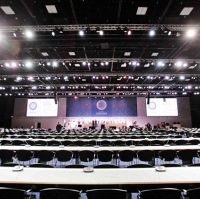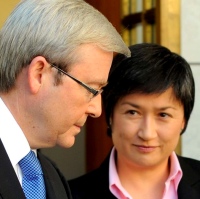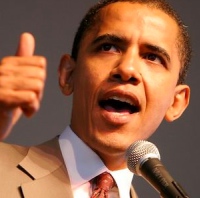- About Us
- Columns
- Letters
- Cartoons
- The Udder Limits
- Archives
- Ezy Reading Archive
- 2024 Cud Archives
- 2023 Cud Archives
- 2022 Cud Archives
- 2021 Cud Archives
- 2020 Cud Archives
- 2015-2019
- 2010-2014
- 2004-2009
 |
Copenhagen: |
The 15th Conference of the Parties to the United Nations Framework Convention on Climate Change (UNFCCC) is underway in Copenhagen. Luckily for Tiger Woods, the Danish meeting has taken the media spotlight in the last few weeks. Both have been dogged by controversy and may have failed to live up to expectations. In time we’ll forget about the failings of one man, but what will emerge when the dust settles on Copenhagen, and, will the world be so quick to move on from any perceived or actual failings?
This article tracks the recent background to Copenhagen, the key issues being debated and what could be expected as the curtain falls. It does not enter the climate science debate, but rather focuses on aspects of the climate change policy environment. Although the former is probably a more noble and useful endeavor, so a second article will explore the current state of climate change science.
Rio to Copenhagen, via Kyoto and Marrakech: Mexico bound?
Copenhagen is the buzz word of the moment. Less well known is that the meeting is one, albeit unusually well publicized, step in a process that has been underway since 1992. In that year in Rio de Janeiro, 192 countries agreed to move towards a global comprehensive and binding agreement to reduce the world’s greenhouse gas emissions. The subsequent ‘Rio Treaty’ can be thought of as the first global agreement in principle, to curb emissions. The parties have since met in most years to continue working towards that goal. Copenhagen is meeting number 15, known as Conference of the Parties 15 (COP-15).
Prior to Copenhagen the most famous of such annual meetings was held in Kyoto in 1997, where the early basis for the Kyoto Protocol was created. Four years later the Marrakech Accord, hammered out in its namesake city in Morocco, solidified the details of the Kyoto Protocol. The emergent Kyoto Protocol is a legally binding agreement of 37 developed countries to contain their carbon dioxide equivalent emissions (emissions) to agreed levels over the period 2008-2012.
The mechanism for emissions abatement in the Kyoto Protocol is an allocation of allowable annual emissions relative to a reference year (1990) level, administered by the UNFCCC. The level of emissions is known as ‘the abatement target’. Most countries have targets for emissions levels below 1990 levels, whereas Australia managed to negotiate a target equivalent to 108 per cent above 1990 levels.
The key feature of the Kyoto Protocol is a set of abatement targets in developed, not developing countries. So called ‘flexibility mechanisms’ allow developed countries to purchase emissions abatement activities sponsored in developing countries, to meet their Kyoto targets. Most of these activities have occurred in China and India. This export of emissions abatement from China and India, mainly to Europe, is the emergence of global emissions trading. The units of emissions abatement, traded as paper, have been highly coveted in their own rights as financial instruments, with highly developed secondary markets in futures and options. Accordingly, hedge funds and investment banks have been active traders and market makers.
The EU has been the most enthusiastic participant in the Kyoto Protocol, and commenced an EU-wide emissions trading scheme (ETS) in 2005 to meet its Kyoto targets. The ETS is now in its second phase (2008-2012) after which a third phase will operate (2013-2020).
Although the Kyoto Protocol does not officially end in 2012, no abatement targets have been set after that year. The intention of the UNFCCC is to commence another Kyoto compliance period or an entirely new successor agreement for 2013-2020 to coincide with the third phase of the EU ETS.
The design and implementation of the Kyoto Protocol has occupied the majority of proceedings in COP meetings since 1997, up until about a year ago. COP-13 held in Bali, and COP-14 in Poznan, shifted focus to what will follow the Kyoto Protocol. At those meetings, Copenhagen was slated as the meeting at which a Kyoto successor agreement, a “Copenhagen Protocol” could be delivered. Copenhagen has been framed in those terms ever since. The broad parameters of such an agreement would relate to the geographical coverage (developed versus developing), the emissions abatement targets, and whether those constraints are legally binding. For example, many had felt that the Kyoto Protocol was a toothless tiger because developing countries such as China were left out. Notwithstanding the US did not even ratify the Kyoto Protocol, further undermining its effectiveness.
The COP meetings themselves are notorious for delivering unexciting outcomes, incrementally. Months prior to Copenhagen, those in the know had already shifted focus to next year’s COP-16 in Mexico as a more realistic, yet still ambitious timeline for a comprehensive global agreement.
2009. Rising tides
Over the same timeframe as the focus shifted to the post Kyoto world, the climate change agenda has taken on a more urgent imperative. This is the result of escalating warnings from the scientific community, glacial and ice cap meltings, an apparent increase in the frequency of extreme weather events such as storms and droughts, and a turn in the political tide in a number of key developed countries. Many Governments have been elected with mandates to enact emissions abatement policies. Copenhagen has therefore assumed particular importance.
This has been a positive factor because it has created political pressure on leaders to accelerate progress towards policies that reduce their economy’s dependency on emitting activities. Countries such as the US, EU, China, India, Japan, Australia and New Zealand have all announced aspirational emissions abatement targets for the years 2020 and 2050. Unilaterally, momentum has gathered although there is a strong preference for countries to create targets on their own terms.
However, perhaps unrealistic expectations have grown around what is an extremely difficult and time consuming process, to create a global comprehensive emissions agreement. Copenhagen should be viewed as a step in the way in an ongoing process underway since 1992, although it is a relatively advanced step by UNFCCC standards. The road to Copenhagen has been beset by the same obstacles that faced the road to Kyoto – it took four years from Kyoto to Marrakech to finalise the details of that agreement, and debate still continues.

Social, political and criminal climate activity ramped up in the months preceding Copenhagen. Just weeks before the Copenhagen meeting, spectacular newsflashes revealed controversy among climate scientists from the Climate Research Unit (CRU) at the University of East Anglia. They were alleged to have manipulated temperature results for climate science publications, destroyed data which did not support their global warming thesis and smeared climate skeptic scientists and their journals. This information was revealed by illegal hacking of the CRU’s email system and file server by unknown persons. The nature of the hack is almost as intriguing as the information revealed.
The incident involved the theft of more than 1,000 e-mails and 3,000 other documents consisting of 160 megabytes of data in total. The hacked information was simultaneously uploaded to various internet locations from IP addresses in Turkey and Russia in the early hours of the morning of 17th November 2009. The files were later uploaded to a server in Tomsk. The hacking incident had the hallmark of professionals - the information recovered was targeted to a set of related emails, documents and data, hacked from multiple locations.
The hacks were followed by waves of death threats and threatening emails to climate scientists in the UK, US and Australia.
The incident, unimaginatively dubbed ‘Climategate’ in the press, served its purpose in temporarily destabilizing the climate debate during the days leading to Copenhagen. The topic flooded international media. It gained traction in the usual quarters: "It appears from the details of the scandal that there is no relationship whatsoever between human activities and climate change" Saudi Arabia's lead climate negotiator Mohammad Al-Sabban told BBC News the week before the summit. A cache of leaked emails, according to the Economist “did not show climate scientists at their best”.
At the very least, airing of doubts about the science should be seen as an opportunity to increase the rigor and improve the communication of the science. Open and constructive debate must be allowed, and the scientific community must continue to refine and improve their analysis, and more importantly to communicate the results to the public and public policymakers.
Copenhagen: Controversy from the start
The first week at Copenhagen went according to the script for high profile international meetings. It started amidst the climategate scandal, followed up with secret documents leaked (the so called ‘Danish Papers’), strong posturing from negotiators, walkouts and conspiracy theories, and arrests of angry protestors outside the meetings. A veritable star wars bar of politicians, bureaucrats, scientists, lobbyists, journalists, protesters and observers sidled up at Copenhagen. All determined to make their mark, make sense of proceedings, or secure their media bytes to report back to eager folk at home. And, a perceived rift between China and US grew as the meeting progressed – typical hallmarks of early negotiations.
During the first week at Copenhagen, the same issues encountered during Kyoto negotiations have re emerged.
Developing versus developed
Since climate change negotiations commenced there has been a stark divide between the interests of developing and developed countries. The latter’s preoccupation with combusting fossil fuels has propelled their populations to unimagined levels of prosperity and technological innovation since the industrial revolution. Developed countries, during their progress up the development curve, account for the majority of the carbon dioxide that now resides in the atmosphere. By that logic, if climate change is the result of such activities, it is the fault of developed nations. It follows that they should do most of the heavy lifting in terms of mitigating and adapting to climate change.

On the other hand, developed countries can equally claim that developing countries, with their high growth rates and increasing share of global economic activity (and emissions) will account for the lion’s share of emissions going forward. Therefore, developing nations should play an equally important part in reducing their emissions footprint. For example, the Intergovernmental Panel on Climate Change (IPCC) estimates that 97 per cent of the growth in global emissions from now until 2030 will be from the developing world, with China accounting for about half of that. China’s spectacular economic growth trajectory, if continued will see it as the world’s largest economy in the coming decades. China overtook the US as the world’s largest emitter in 2007.
This impasse has re-emerged at Copenhagen, and once again will need to be resolved. Under the Kyoto Protocol, only developed nations committed to reducing emissions to the specified targets. Such a compromise is less likely now, given the increasing importance of developing countries in generating emissions. Any global action on emissions would be ineffective without the world’s greatest emitters involved.
The most visible manifestation of the developing-developed schism is the standoff between US and China. China dismissed as immaterial the US pledge to reduce its emissions to 17 per cent below 2005 levels by 2020, with further reductions to 2050. The US retorted that China’s pledge to reduce its emissions intensity by between 40 and 45 per cent by 2020 is well short of the mark; particularly given China’s rapid economic growth will lead to increased overall emissions even with these intensity improvements. Furthermore they quote a reportby the International Energy Agency (IEA) which projects China’s emissions intensity to improve by a similar percentage regardless of any climate change policies. This is because developing countries become less energy intensive (when measured on a per unit of economic activity metric) as they become more advanced, as is the case with China. In addition, The US and others argue that China, as the world’s third and soon to be second largest economy, can no longer hide behind the G-77 bloc of developing countries.
China has dug in even more deeply on the issue of binding agreements, stating that any emissions reducing activities they undertake will not be subject to verification by other countries or the UNFCCC.
Another sticking point in climate negotiations to date is the financial assistance that could be passed from developed to developing countries. Such funds would be used to assist developing countries with adaptation efforts and also to assist the transition to lower emissions technologies in power generation.
For example, the following text derives from the negotiating draft of an agreement document prepared in advance of Copenhagen:
"Developed country Parties shall provide financial resources and transfer technology to developing country Parties to make full and effective repayment of climate debt, including adaptation debt, taking responsibility for their historical cumulative emissions and current high per capita emissions."
This runs counter to the views of, for example, the UK. Sir Nicholas Stern, author of the seminal Stern Report on climate change for the UK Government, has rejected the notion of a carbon debt that developed nations must pay to developing nations.
The conservative estimates of such a carbon debt from the World Bank are of US$ 75 billion per annum – the high end of the range is US$ 400 billion per annum. The EU has pledged to commit to a ‘fast-start’ fund that could amount to a more modest US$ 30 billion spread over three years. Such pledges have been cried out of the house by least developed countries and tiny island nations.
Importantly, in the recent debate China has distanced itself from the range of countries seeking repayment of carbon debt.
Kyoto or not?
Copenhagen negotiators are split along similar lines about whether or not to retain the Kyoto Protocol post 2012. Developing countries such as China and India have vigorously supported the continuation of the Protocol. You don’t have to be Pythagoras to work out what they’re angling for – the abatement targets under the Kyoto Protocol only apply to 37 developed countries. On the other side of the coin, developed countries believe that the Protocol is ineffective without large emitters such as India and China (and of course the US) on board. The US, which accounts for about 40 per cent of global emissions, did not ratify the Kyoto Protocol.

Cool runnings
The IPCC reports that limiting warming to 2 degrees C above pre industrial levels will still lead to sea level rises of 0.4-1.4 metres by 2100. Global emissions reductions of 25-40 per cent below 2000 levels by 2020 are loosely correlated with the 2 degrees C warming target. Weaker abatement activity may lead to rises of 3-4 degrees C, and doing nothing would lead to 4-6 degrees C and catastrophic sea level rises. By that logic, even with aggressive action to curb emissions and temperature rise confined to 2 degrees C, tiny islands such as Tuvalu and Kiribati will be submerged later this century. The early days in Copenhagen were thus characterized by emotional pleas from the Tuvalu delegation, asking for the most aggressive action to reduce emissions by developed and developing countries. These requests have so far been rejected.
Another issue being debated at Copenhagen is the treatment of land use, land use change and forestry (LULUCF) in emissions abatement measures. Australia, as a result of some nimble negotiating, was the only country allowed to include LULUCF emissions in its 1990 baseline for the Kyoto Protocol. This, the ‘Australia clause’ in the Kyoto Protocol, is now well known and Australia has been the subject of considerable derision over what is perceived as an accounting trick. 1990 was a massive year in land clearing in Australia, which has made it relatively easy for Australia to meet its (108 per cent of 1990) Kyoto emissions target, despite emissions from other sectors increasing by over 80 per cent. The Government achieved this by placing regulatory restrictions on land clearing activities. New Zealand is also arguing aggressively for the inclusion of LULUCF provisions in any future agreement, which has ruffled many feathers.

What realistically could be achieved?
The aim of the Copenhagen meeting is to create a binding agreement to reduce global emissions. The most essential part of this is a set of binding emissions targets for each participating country, with a close second being the degree of support to developing countries to help them achieve their transitions to low emissions economies. Supporting this will be a massive set of rules by which participants must abide, in terms of what constitutes emissions abatement, how the targets are calculated, and how emissions abatement ‘certificates’ can be traded among countries. The issue of binding emissions targets will be the main focus of the second week of Copenhagen negotiations as the arrival of country leaders will step up the urgency for ‘announceables’ and PR.
To expect that this entire program could be hammered out in two weeks is unrealistic. Regardless, whatever is agreed it will not likely be implemented until after 2012 when the first Kyoto compliance period ends.
Most likely, a political agreement will be announced with some notional commitments to emissions abatement targets by 2020 and 2050. Perhaps the most significant development will be the announcement of a follow up agreement to Kyoto. It will sound good. Impressive country-specific initiatives into clean energy and research and development will be announced. China and India will likely surprise on the upside, offset by the US and Australia - too constrained by domestic politics to offer anything concrete. Overall, detail will be light and there will be many gaps and wriggle room.
Work on the details will commence with some sort of notional timeline – perhaps COP 1

6 at Mexico
What emerges may not be the UNFCCC’s ideal model of a centrally administered and specified global comprehensive agreement. An alternative model proposed by the US and China, when they agree on something, is that of ‘pledge and review’. That is, countries formulate their appropriate emissions abatement targets and strategies independently, within some broad common parameters that allow trade and adjustment between countries. For example, both the US and Australia are attempting to enact emissions reducing policies in the form of domestic emissions trading schemes, similar to that of the EU. However, both the US and Australian schemes are bogged down in the domestic political process and as such, there is a limit to what the Governments of these countries can commit to and take back to their constituents. The US President has been warned by Republican Senators not to commit to anything in Copenhagen that won’t be passed in Congress.
The wash
Many will judge Copenhagen a failure because the silver bullet of a comprehensive, legally biding global agreement to reduce emissions will not be delivered in completeness. Those demanding tough action will find more sizzle than steak.
It is important to place Copenhagen in its longer term context and consider that the democratic process lends itself to consultation, planning, dialogue and consensus – with predictable implications for timelines. It is the same people who have campaigned tirelessly for freedom and democracy over the years who now cry out for draconian, command and control measures to combat climate change. Many feel that the environment will not await the slow plod of democracy. Hopefully it is not left to time to judge whether they are right.
In Copenhagen, another important step down the road towards a global climate agreement has been passed, perhaps too slow for most.
